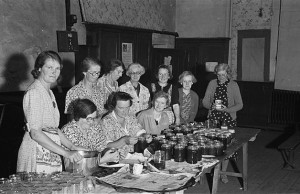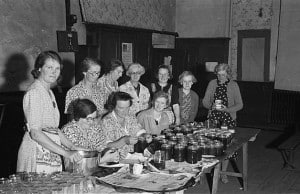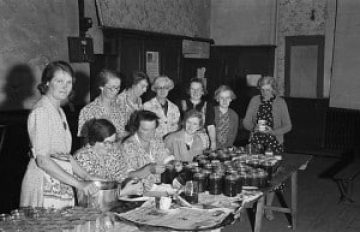 Rainy afternoons are plentiful in Oregon, and on such a day there is nothing quite like a jigsaw puzzle, Miss Marple, and a little benevolent neglect of your child. I recently watched our heroine solve a mystery of poison pen letters that had been typed using a machine at the Women’s Institute. I’d heard that term before in other BBC contexts and resolved to learn more. Happily, my favorite documentary presenter, Lucy Worsley, did a show on the Women’s Institute. Unhappily, the version on youtube is poorly formatted. Still, I learned a lot.
Rainy afternoons are plentiful in Oregon, and on such a day there is nothing quite like a jigsaw puzzle, Miss Marple, and a little benevolent neglect of your child. I recently watched our heroine solve a mystery of poison pen letters that had been typed using a machine at the Women’s Institute. I’d heard that term before in other BBC contexts and resolved to learn more. Happily, my favorite documentary presenter, Lucy Worsley, did a show on the Women’s Institute. Unhappily, the version on youtube is poorly formatted. Still, I learned a lot.
Evidently the Women’s Institute is a Canadian and British organization for rural women that began a century ago and involves monthly meetings where women gather to learn skills, do crafts, and enjoy treats. That sounds familiar, doesn’t it?
Well as I was watching the documentary I couldn’t help thinking “I want to be in the Women’s Institute! I wish we had them here! I wonder if I could start one?” After a moment I recalled that I do, in fact, belong to a women’s organization. Why wasn’t it exciting to me then? What was different about the WI?
According to Ms. Worsley at chapter meetings the women hold regular votes on “everything from the choice of an assistant treasurer, to the day’s great issues.” We then see a scene from a WI meeting in which a woman reads out a resolution to the group: “As we mark the first 100 years of the WI, we deplore the unacceptable level of gender discrimination that still exists today.” The camera cuts to the members voting on the resolution — some for, some not, and secretary carefully tabulates the votes and records them in the minute book. Lucy underlines out how brilliantly democratic the system is, predating the time when women could vote in national elections.
Later in the presentation, she explains the national structure for WIs: “The Women’s Institute’s democratic structure gives individual women a powerful voice. Any member can propose a resolution, which is voted on in the Institute’s AGM [Annual General Meeting]. And if it’s passed, the Institute throws its full weight behind a national campaign on that issue.”
Here then are some of the key things I noticed about the WIs:
- They choose their own leaders by vote.
- Members vote on specific rules to guide their chapter meetings (e.g. “only one kind of cake shall be served” after a meeting in the Llanfairpwllgwyngyll WI)
- They discuss issues and vote on them
- Consensus is not expected or required
- Dissenting votes are also recorded
- Members propose the agenda of the larger organization
- Members have an opportunity to dissent publicly from that agenda
- The organization uses its united power to effect change on a national level for issues that women feel are important to them.
In many ways, the WI as portrayed in the documentary looked remarkably like any Relief Society meeting I’ve ever been to. They began by singing Jerusalem to the accompaniment of an electric organ. Most of the members were older. They had craft fairs, and canning classes and homemaking lessons. They sat down for refreshments after the meeting. And yet the structure had a key difference: The voice of the women mattered.
When have I ever been asked to help decide the RS goals or focus for the year? Do I have any choice in who the presidency will be? Do we ever discuss current affairs in a way that allows for a variety of opinions? Is there a mechanism for the general leadership to hear my voice? Do they care at all what I think or feel is important?
The reason, I submit, that I felt so energized and excited when I learned about the WI is that it is a women’s organization. It is run by women, led by women and the voices of women matter. It is an organization that exists to meet the needs and improve the lot of women. I don’t feel excited about Relief Society because although it has much in common in terms of format and content with the WI, it is fundamentally not a women’s organization. The leaders are chosen by men, the classes are about the experiences and teachings of men, the budget and activities must be approved by a man and the proposals and opinions of women are entirely dependent on the goodwill of a man to be carried forward.
Do you feel excited about being part of the Relief Society (or have you in the past?) What would make you feel more engaged with it as an organization?






9 Responses
For an artistic take on WI, try the movie “Calendar Girls.” Delightful fun.
I remember when it came out, but I never saw it! Fundraiser for the RS retreat?
I would love to be part of a WI organization! I have never felt that my voice mattered on RS. Just a bum on a seat to tally. So I rarely attend these days.
Also, Home Fires on PBS is based on the Women’s Institute.
I love the legacy of the UK Women’s Institute! In Australia, there is a similar organization called the Country Women’s Association (CWA). That is a great group too, and works in much the same way as the English WI. Before DH and I loved to the outback, a woman in the ward where we attended pressed me to become involved in the CWA. Her reasons were that there was no Relief Society (or church)– and the group would be supportive , add diversity and culture, and just be fun. She was right!
But to answer your question– No. I do not feel excited in the least about being in Relief Society. The Mormon feminist community is the only group that inspired me to start attending relief society– and even now, I really am not comfortable there at all. The most difficult part for me is the whole teaching of the prophets series. I think that the narrow focus on men’s teachings bleed into all of the aspects of the Relief Society and have undermined the feminine glory days of women teaching women. In deifying the man and men’s teachings, (as Mormon do with Prophets) women are forced into yet another corner where we become indentured servants to all men in the church– liberation is only in leaving the church, death, or having a kind enough Bishop to allow -and ENCOURAGE- Relief Society autonomy.
I wish I liked the Relief Society. But I don’t. I don’t feel safe there. I think, to answer your second question, I would prefer to choose whether I am a member or not, elect RS leadership myself, and have each independent RS create their own board of directors based on the needs and wants of the group– i.e. widowed women’s rep, young mother’s rep, working women’s rep, furthering education rep., etc. Not just “compassionate service” and “home-making” etc. reps.
I don’t think it’ll happen. But it is nice to dream.
I also realized after writing this that choosing to be a member matters. I’m a “member” of the Relief Society because I was baptized at 8 and later turned 18. I never joined it. I’ve been in YW and Primary for years now and barely attend. It’s hard to feel like I’m part of an organization I didn’t really join and now cannot attend because it directly conflicts with my church responsibilities
I loved learning about the WI from your post. I think I would enjoy being a member of a woman-governed organization like that. Relief Society is not exciting to me. I see it as a class to attend on Sundays, and women don’t have authority to do anything more than small, short-term local projects through the Relief Society.
We were better before we were “correlated”. I do like meeting together as sisters; better than nothing! (Which isn’t saying much!).
No, I do not feel valued in Relief Society or that I have a voice or right to an opinion. The Enrichment activities are flavored by the leader and her interests and not relevant to the group. The lessons are boring and redundant and fall short of the connection women desire. The leaders seem like they don’t want to be leaders but that they are just filling their calling out of duty. I miss the passion, purpose and autonomy that seemed so vibrant in the early Relief Society. I